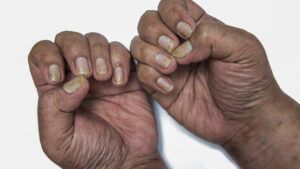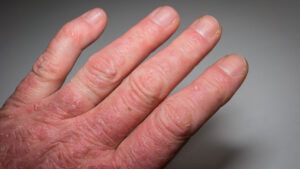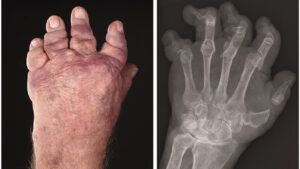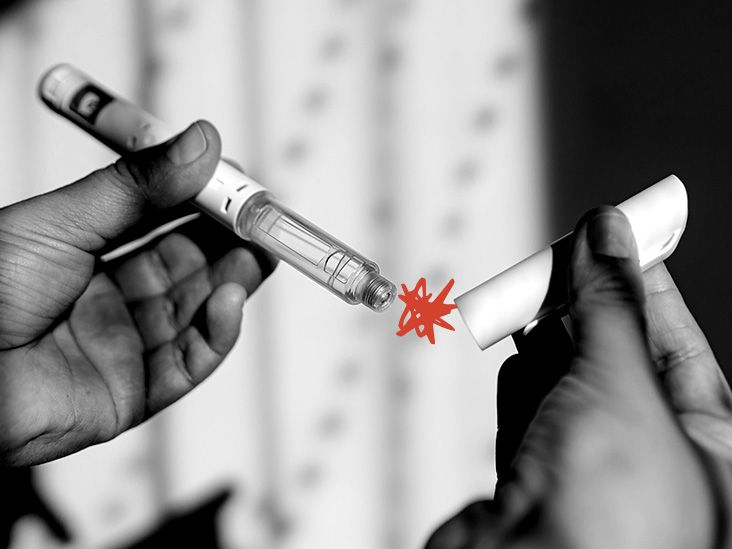Psoriatic arthritis (PsA) causes inflammation in the joints, including in the hands and fingers. Treatments and home remedies can help manage symptoms.
Psoriatic arthritis is an inflammatory joint condition related to psoriasis. An estimated 30 percent of people with psoriasis also develop psoriatic arthritis.
When PsA affects the hands, it can break down the joints and limit a person’s mobility. It may cause swelling, stiffness, and inflammation in the hand and finger joints.
Here are some pictures showing how PsA can affect the hands.





PsA symptoms can range from mild to severe. Many people experience flare-ups when symptoms worsen but also experience periods in which symptoms lessen or disappear.
When PsA affects the hands, it tends to affect the joints closest to the nails, which can cause swelling in the fingers. As a result, some people confuse PsA with gout.
Arthritis symptoms in the hands can disrupt daily life. PsA may affect one hand more than the other, and it may affect a single finger.
Symptoms of PsA in the hands
- stiff, painful finger and hand joints
- destruction of bony tissue, known as osteolysis
- a shortening of the fingers
- problems with the small joints
- severe deformities in the hands
- “pencil in cup” deformities in the fingers
- swelling along the entire length of the fingers
- swelling that mainly affects the middle finger joint
- unusual shape to the fingers and finger joints
- pain where the tendon or ligament attaches to the joint
- pitted nails
- onycholoysis, which is when keratin or skin cells collect under the nails and push them up
- uveitis, a type of eye infection
- a reduced range of motion in affected joints
- fatigue
Onycholysis can look like a fungal infection, but no fungus is present.
Aside from the hands, PsA may also affect the following areas of the body:
- ankles
- knees
- lower back
- feet and toes
PsA develops in around
People can use certain home remedies to help relieve the symptoms of PsA and prevent the condition from getting worse.
When someone experiences a PsA flare-up, the following home remedies can help:
- moisturizing often, especially after washing the hands
- applying ice to affected hand joints for 10 minutes at a time, repeating as needed, to help reduce inflammation and swelling
- alternating hot and cold treatment or wearing warm mitts
- treating fungal nail infections with antifungal creams or tablets
- keeping fingernails trimmed and smooth to prevent injuries that can cause flare-ups
- avoiding pulling or trimming the cuticles, as this can lead to injuries and flare-ups
- limiting the time spent soaking the hands in water, as this can dry out the skin
- avoiding acrylic or fake nails, as they can injure nail beds
- carrying out exercises that a physical therapist has recommended
People with PsA may also notice their symptoms improve with lifestyle measures such as:
- eating a balanced, nutrient-rich diet
- getting regular exercise
- maintaining a moderate weight, which may include losing weight, if necessary, to reduce the stress on joints
- managing stress
- quitting smoking, if they smoke, and avoiding secondhand smoke
- avoiding alcohol
- keeping the skin moisturized and protected
There is currently no cure for PsA, but treatment can help manage symptoms and address the underlying causes.
Biologic drugs are the
People who cannot take biologic drugs may benefit from oral small-molecule drugs, another form of emerging treatment, or a disease-modifying antirheumatic drug, known as a DMARD.
These drugs can change how the immune system works, reduce inflammation, or both. They can reduce the severity of symptoms and frequency of flares, and they may also reduce the long-term effects of PsA.
Treatment that can help relieve symptoms include:
- anti-inflammatory medications for joint swelling and pain
- creams to relieve skin itchiness and discomfort
- phototherapy to help prevent skin flares
- corticosteroids to reduce inflammation and ease joint pain
Steroid drugs are only suitable for short-term use due to the risk of adverse effects.
Some people with PsA in their hands may benefit from surgery. Surgical treatment varies based on the joints affected and an individual’s specific symptoms. A person can speak with a doctor about surgical options.
A person should consult a doctor if they have undiagnosed joint pain and stiffness alongside other symptoms of PsA.
An individual should also contact a doctor during flare-ups and inform them of any changes to symptoms over time.
No laboratory test can show that a person has PsA, but tests may help rule out other conditions with similar symptoms, such as:
To diagnose PsA in the hands, a doctor will typically:
- review symptoms
- ask about the person’s medical history and family history
- examine the wrist, hands, and fingers to look for swelling, skin rashes, and nail pitting
- order X-rays to check for joint damage and blood tests to look for markers of psoriatic disease and rule out other conditions
If a person has a history of psoriasis, arthritic changes may be due to PsA. Skin changes and PsA often occur together, although they may not appear at the same time.
If the doctor suspects PsA, they may refer the person to a rheumatologist. This type of specialist focuses on arthritis and other musculoskeletal diseases.
Early diagnosis and treatment can greatly improve a person’s outlook.
Treatment can slow the progress of PsA and help
- persistent inflammation
- permanent joint damage
- eye and vision problems due to uveitis
- a severe effect on the person’s quality of life
- other conditions, such as high blood pressure, which doctors call comorbidities
Comorbidities
A comorbidity is a condition that is likely to occur alongside another condition. The exact link between comorbidities is often unclear, but inflammation appears to play a role in many of these conditions.
The following symptoms of metabolic disorder are also more likely to appear in people with PsA:
- obesity
- hypertension
- high levels of cholesterol and triglycerides in the blood
- type 2 diabetes
- heart disease
Current guidelines urge doctors to monitor people with psoriatic disease for these conditions.
Other
- uveitis, an inflammatory eye condition
- Crohn’s disease
- depression
- osteoporosis
- nonalcoholic fatty liver disease
- fibromyalgia
PsA can cause discomfort in the hands and other affected areas of the body. It can affect a person’s mobility and quality of life.
There is currently no cure, but treatment
The outlook is often worse for people with:
- a large number of inflamed joints
- damage that is visible in medical imaging tests
- reduced ability to carry out daily tasks
- lower quality of life
Here are some answers to questions people often ask about PsA in the hands.
What does psoriatic arthritis look like on the hands?
Common symptoms
How can I manage psoriatic arthritis in my hands?
A doctor will typically prescribe medications that can help manage symptoms and reduce flares. For many people, these drugs are effective. Other options include avoiding or quitting smoking, following a varied and nutritious diet, using warmth to soothe discomfort, and using creams to keep the hands moisturized.
What can trigger psoriatic arthritis?
Experts do not know precisely what causes PsA. It appears to happen when genetic and environmental factors combine to cause an immune reaction that leads to inflammation throughout the body. The symptoms come and go, and they worsen during a flare. Triggers for a flare include stress, an infection, cold weather, and the use of certain medications,
Psoriatic disease is an inflammatory condition that can lead to skin symptoms and PsA.
A person with PsA in their hands will experience pain, swelling, and bone damage in their hands. PsA can cause the fingers to change shape, making hard to use the hands for daily tasks.
Ways of managing symptoms include taking medications, using home remedies, or both. Moisturizing the hands regularly, treating fungal nail infections, and attending all medical appointments can help manage PsA and its complications.
Treatment can slow the progression of the disease, help ease symptoms, and prevent permanent joint damage.


